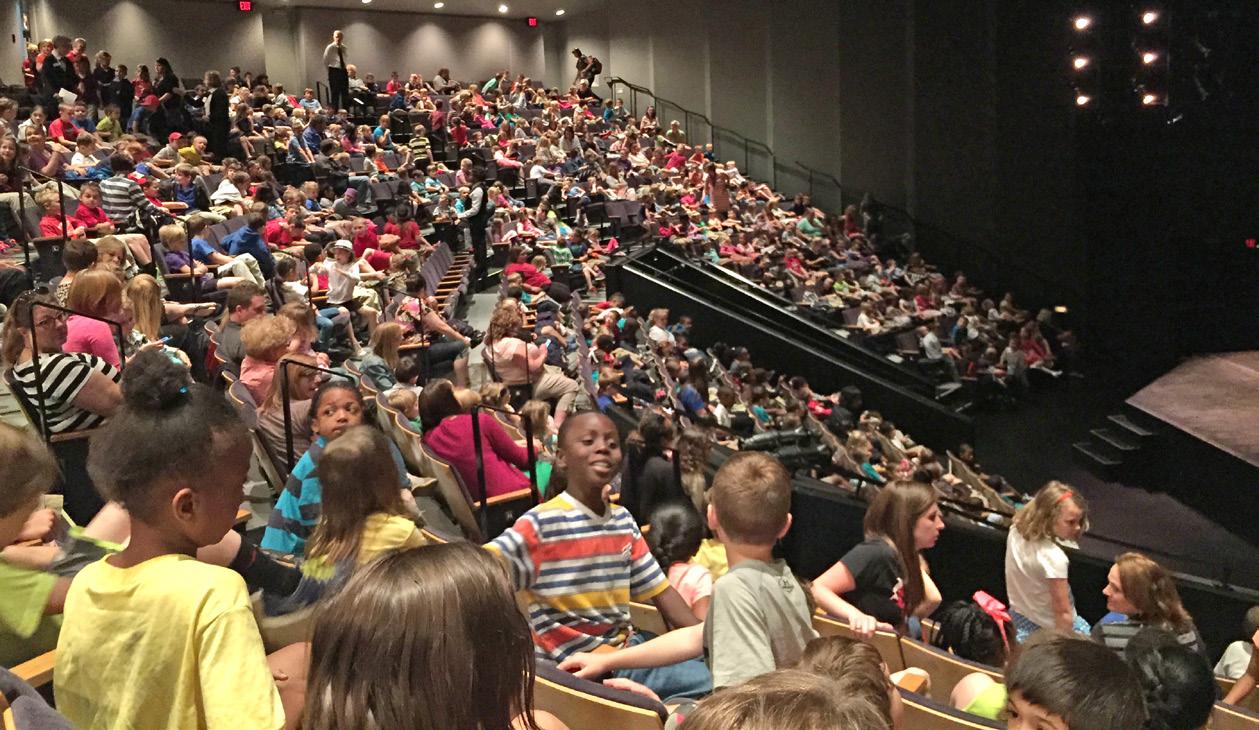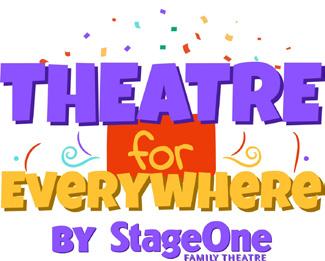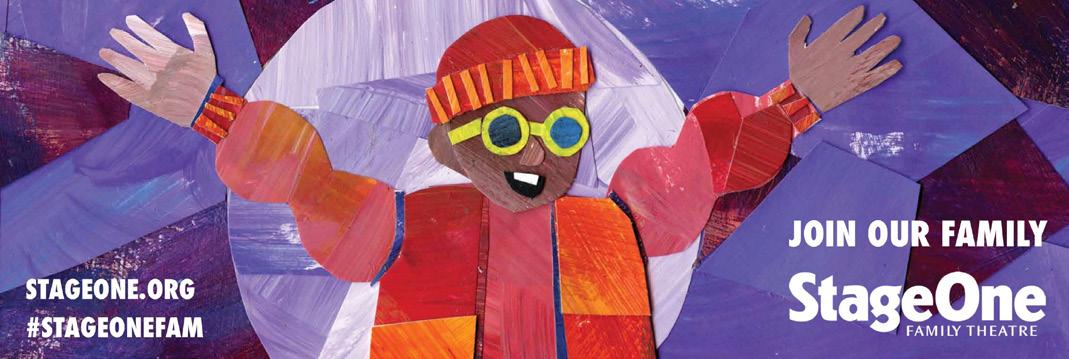
14 minute read
ADVOCATING FOR THE ARTS
ADVOCATING
for the ARTS
Advertisement

FUND FOR THE ARTS PRESENTS TOP HONORS TO KEN CLAY AND DARREN HARBOUR
Awards season is here!
After postponing due to the pandemic last year, Fund for the Arts is now celebrating the 2020 winners of its distinguished Awards in the Arts, which recognizes leaders who are cultivating Louisville’s vibrant arts community. Among the honorees are Ken Clay, recipient of the Lifetime Achievement in the Arts Award, and Darren Harbour, recipient of the Emerging Leader in the Arts Award. We had the opportunity to connect with both recipients to learn more about why they are so passionate about the arts. Please join us in congratulating them both!
KEN CLAY
2020 Lifetime Achievement in the Arts Award
At the age of 81, Ken Clay has not only lived through Louisville’s explosive growth, he has also played a key role in cultivating the Derby City’s arts community.
When the call for Awards in the Arts nominees went out, nominations were accepted from fellow artists, patrons, and the general public. Past award recipients served as the “committee” to determine which of the nominees would be named the 2020 winners.
When Fund for the Arts called to inform Clay that he won, he says, “I was just overwhelmed with it. It’s something that I’ve always admired, as far as lifetime achievement awards. I was delighted to have been a recipient. I’m very appreciative of that award.”
Clay was born and raised in Louisville. When he was younger, he and his brother, Cecil, would sing doo-wop together. By the time he was in high school, Clay was involved in opera and classical music, though it was clear that jazz had a special place in his heart. “Music was a major direction that attracted me to the arts,” he says. Another formative experience for Clay was going to Walnut Street, now known as Muhammad Ali Boulevard, on Saturdays. “Old Walnut Street” was a booming business district and social gathering place for African Americans before the Civil Rights Act of 1964. He compares the old Walnut Street to Memphis’ Beale Street.
“On Saturdays, we used to go to the movies to see the features,” Clay says. Then came “The Midnight Ramble” a live performance by the Chitlin Circuit that featured Black entertainers. It was this fellowship and entertainment that gave Clay a place to belong — and it would serve as a foundation for his vision of what the arts community in Louisville could become.
The late 1960s, Clay established the Corner of Jazz, the first black culture shop in Louisville, selling books, music, sculptures,

Ken Clay is the 2020 recipient of the Lifetime Achievement in the Arts Award. Photo courtesy of Fund for the Arts.
The Awards in the Arts honors artists and arts organizations for their passion and dedication to the arts, and in doing so, celebrates and advances Greater Louisville’s vibrant arts and culture.
— Ken Clay
and local art by African Americans. The civil disturbance in 1968 began right there at the intersection of 28th and Greenwood, and the Corner of Jazz served as a safe haven for many in the community.
“Back in the ’70s, I founded an organization called Renaissance Development because I wanted to bring more arts to the inner-city communities,” Clay says. Partnering with the Louisville Urban League, Renaissance helped raise artistic awareness in the inner city. The goal was to help visual artists bring their exhibits to schools, clubs, and public places. But it wasn’t just visual artists. “We helped performing artists do the same,” Clay adds. “We also started a dance company.”
While working with Renaissance, Clay raised money by knocking on doors of potential sponsors. During his efforts, someone told him about the “new arts center being built.” Clay would later meet Marlow Burn, the developer of The Kentucky Center for the Performing Arts. This serendipitous encounter led to Clay joining the Center’s programming department.
The first public show that Clay produced was a gospel extravaganza, which included gospel groups from across Kentucky. One of the standout performances of the night was by Rev. James Cleveland and his group. “I was pleased with that show,” Clay says proudly.
Clay’s early success paved the way for him to become the Vice President of Programming at The Kentucky Center. “One of my chief responsibilities and goals was to get Black people into the Center,” Clay says. His experiences attending the midnight series at the Walnut Street Theater inspired him to start the Midnight Ramble Series, a schedule of five shows a year that featured different artists, especially Black artists, from across the country. One of these shows, called the “Walnut Street Review,” featured local Black artists. “That was a big success,” he says.
But for Clay, his vision went beyond the walls of The Kentucky Center.
“The arts have played a vital role in bringing people together,” he says. “The arts need to be appreciated on those community levels, not just in the polished performing halls but also in the community centers, in parks and other places where people gather: churches, schools, etc.” During his first year at The Kentucky Center, Clay spent the summer going to community centers in Louisville to do outreach, which would later be dubbed ArtsReach Louisville.
“People in community centers knew a lot about athletics, but didn’t know a lot about the arts,” Clay says. He gathered friends who were jazz artists and began visiting the centers. “We helped the mentors at the centers learn about the arts so that they could effectively relate with young people about the arts.”
Today, ArtsReach is a statewide initiative that has “expanded considerably” and received recognition as one of the top outreach programs in the country.
For the past 20 years, Clay has also been the producer for all the entertainment at Louisville’s WorldFest, a four-day international festival. “We can be very proud in Louisville [for] what the arts have accomplished both in terms of our international communities and African American communities,” he says.
Clay co-authored the book, Two Centuries of Black Louisville, featuring untold stories and rare, historical photos. Now, he is collaborating with four other authors to craft a tribute to the African American entertainers and musicians of Louisville.
When reflecting on the growth of his hometowny, Clay has nothing but encouraging words for the next generation: “I’m continuously amazed by the contributions that young artists are already making. Under the proper guidance and encouragement, there’s a great future for young artists in Louisville.”
DARREN HARBOUR
2020 Emerging Leader in the Arts Award
The Fund for the Arts recognized Darren Harbour with the 2020 Emerging Leader in the Arts Award for his inspiring impact on this community and its people.
In 1999, Harbour’s family moved to Louisville from Gary, Ind. As a child, he was a passionate visual artist who spent his time drawing, coloring, and painting. His dream was to create comic
Darren Harbour would like to recognize the team at Imagine Blind Players:
Darren Harbour B.T. Kimbrough Patty Cox Barbara Henning Ben Wright Charmaine Walker Helana Keaton Emery Jasmine Ross Jennifer Star Jennifer Wreath Katy Carpenter Mandy Cox Pamela Cox Sharri Anderson Sandra Williams Sue Ellen Melo Thomas Saling Terri Terlau Tanya Johnson Tavian Taylor

Darren Harbour is the 2020 recipient of the Emerging Leader in the Arts Award. Photo courtesy of Fund for the Arts.
books. Harbour was also a performer in his elementary school plays, though he jokes that he probably would have enjoyed working on the costumes and set design more as a visual artist. But Harbour’s eyes were changing. He was diagnosed with Retinitis Pigmentosa (RP) Cone Rod Dystrophy (CRD), a degenerative eye condition that gradually caused him to lose most of his sight by age 22. “Through losing my sight and my ability to do visual art, I found I was losing my sense of artistic expression and gratification,” Harbour says. “I was looking for something to give me the same sense of fulfillment that drawing once did.” However, being legally blind, Harbour says that he often experienced rejection, no accommodation, stereotypes, and even “false inclusion.”
He eventually came to the Braille Readers Theater at American Printing House for the Blind in Louisville. “My braille is not very good,” Harbour admits, “because I lost my sight later in life.” But he made friends at the theater and promised that they would “one day be doing a play without their canes and dogs.” Harbour didn’t know how it would happen, but he says he was the “Brave Little Toaster and I kept going.” A few years later, Harbour joined the WhoDunnit murder mystery dinner theater in Louisville. “Not only are you coming on stage showing your body language, but in-between scenes, you’re walking around tables so that the audience can grill you and take their best guess at the end,” Harbour says. “I was worried about knocking drinks over, putting fingers in food. What if I tripped over something or went to the wrong table?” At the end of the season, the WhoDunnit crew was impressed with Harbour’s talent and dedication. “You all let me in here,” he joked with them. “I have a whole slew of people who are blind,” meaning his friends at the Braille Readers Theater. “Why don’t you just let them in?”
— Darren Harbour
The WhoDunnit team took Harbour out to dinner and told him that they wanted to help him produce a play. And thus, Imagine Blind Players was born. Soon after, the paperwork was filed and the organization was officially established as a 501(c)(3) nonprofit. The inaugural show for Imagine Blind Players was an original play written by the WhoDunnit murder mystery team, titled Lady Anderly’s Rose. “It was almost too much,” Harbour says, “and that’s why I liked it.”
Everyone who performed in Lady Anderly’s Rose has a “diffability,” as Harbour puts it, meaning a “different ability,” rather than disability. It was important to Harbour to provide his actors with the opportunity to move on stage, learn blocking, and perform their own stunts.
The musical featured four different dance sequences, including a highly choreographed ballroom dance. Harbour hired a professional ballroom instructor to help the players pull it off. The cast had to learn multiple songs, and they also had to walk around to the dinner tables in character.
The musical was a rousing success, not only for audiences, but for the personal growth of the players as well. Aside from the inaugural performance, a key memory for Harbour is when Imagine Blind Players won the theater award for “Best Fight Scene in Louisville” for their performance of California Suite. The stage combat was so believable that audience members took to the stage to break up the fight because they thought that it was a real brawl — that something had gone wrong during the play. For Harbour, his goal is to give those with “diffabilities” the safe space to set aside the canes and dogs and say to the world, “We can do this just like you.” In the works is a podcast where those involved with Imagine Blind Players will talk about how it started, the journey, the challenges they met, and the triumphs they shared together. Harbour is also looking forward to the eventual end of the pandemic so that the group can continue to fulfill its mission. Until then, he’s excited to be the first blind person to compete in professional wrestling. His slogan? “Grindhouse is now the blindhouse; I’m taking over.”

StageOne’s 75th Anniversary
Looking Back and Playing It Forward
by StageOne Family Theatre

If you attended elementary school in Louisville, there’s a good chance you’ve enjoyed the thrill of seeing a StageOne play. For many students, this is the first live play they’ve ever been to. The experience includes the excitement of boarding a yellow school bus and pulling up just outside the Kentucky Center, climbing the steps inside to take a seat in the Bomhard Theatre.
The performance might be a classic like The Snow Queen or Charlotte’s Web, or perhaps one of over 30 world-premiere shows like And in this Corner: Cassius Clay, Harold and the Purple Crayon, or even last year’s celebration of the 150th anniversary of American women’s suffrage, Lawbreakers! (A Fast and Furious History of Women’s Suffrage). Or it might be the beloved annual production of The Best Christmas Pageant Ever, performed by 32 student actors alongside a slate of professional talent. Audience members who were lucky enough to catch a StageOne performance in the early ’70s may have even seen Diane Sawyer on stage!

There’s a long list of titles to draw from, because next month StageOne Family Theatre kicks off its 75th anniversary celebration. The year-long event honors the enduring power of theatre and education, including the organization’s impact to millions of people across the greater Louisville community and beyond.
The tribute begins with the virtual My StageOne Story initiative, which collects personal testimonials from people who have been touched by a StageOne performance or program. Beginning in April, the organization will also offer a single-barrel commemorative bourbon bottle gift to donors, with plans to expand events and experiences for artists and audiences throughout the year.
While StageOne performances have called The Kentucky Center home for the last 30 years, the stage isn’t the only place where this Louisville staple has brought the transformative power of theatre to young people across the region. Every year, thousands of kids from pre-K to 12th grade experience StageOne in their classrooms through arts-integrated in-school residencies.
As a part of these programs, students engage in the dramatic process, giving them an opportunity to meet academic objectives as they connect theatre with another subject. Relationships with Jefferson County Public Schools and the Archdiocese of Louisville have helped StageOne keep a finger on the pulse of the academic and social-emotional needs of students, especially with regard to diversity, representation, and response to the global pandemic.
In addition, the organization’s popular Storytellers performances bring to life familiar stories for StageOne’s youngest audience members, and both year-round DramaWorks Academy and popular summer camps light up the lives of future performers and theatre lovers.
But it wasn’t enough to reach regional students with an interest in theatre and the performing arts. With careful attention to accessibility and equity, StageOne launched an innovative ticket underwriting program in 2010 called “Play It Forward,” which has helped reduce the cost barrier for students attending productions with their classrooms.
StageOne is also a certified Autism Friendly Business and, in 2013, became the first Louisville performance organization to introduce sensoryfriendly performances as a staple of their mainstage season. And that’s not all. StageOne regularly partners with the Girl Scouts for STEAM events and hosts yearly celebrations for community members served by local outreach organizations as well.
Concerns about reaching students have been particularly highlighted in this last year during the global health crisis. StageOne’s Andrew D. Harris, who stepped into the role of Producing Artistic Director just weeks before the pandemic began, has helped address these evolving student needs with new flagship programs that are shepherding the organization into the digital era. Under his direction, the organization launched both Theatre for Everywhere and Channel StageOne within Harris’ first six months of leadership.
Theatre for Everywhere is an engaging virtual program that’s flexibly designed to fit both distance-learning and in-person curriculums. In addition to providing performance opportunities for Louisville artists, the three plays developed for this pilot were created with attention to social-emotional learning and center on timely, relevant topics like recognizing and celebrating racial differences, identifying big emotions, and navigating peer conflict. StageOne is currently providing these virtual performances to 149 schools across four regional districts, serving 64,000 kids in their first three months of operation. This winter, they’re taking Theatre for Everywhere nationwide.
For over 75 years, StageOne has been a cornerstone for an arts community that’s more accessible, creative, empathetic, and engaged. Through their innovative new digital performance series and a host of upcoming activities, this longstanding Louisville staple continues to look ahead to ways they can provide Theatre For Everyone.
LEARN MORE
Learn more about how to access Theatre for Everywhere digital performances, share a My StageOne Story, or check back for more information here about ways StageOne Family Theatre is celebrating 75 years in our community.





